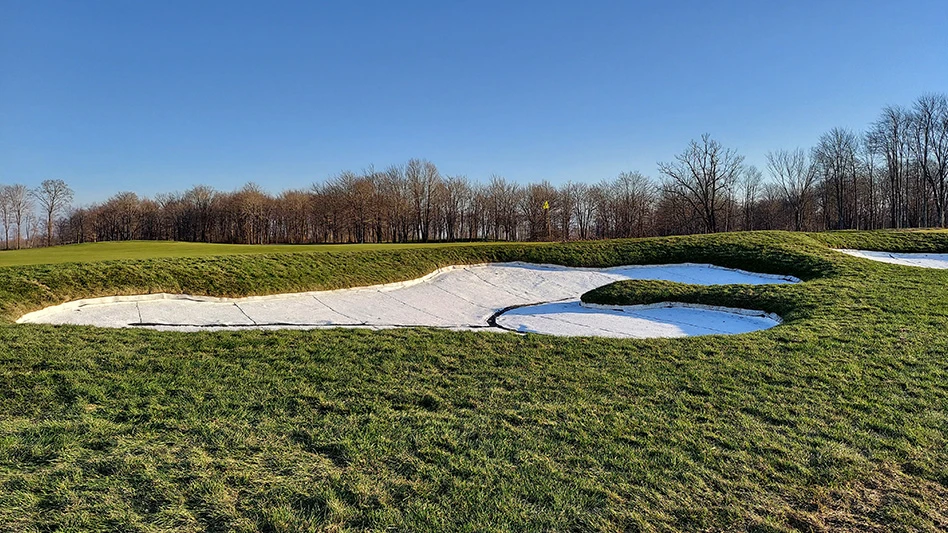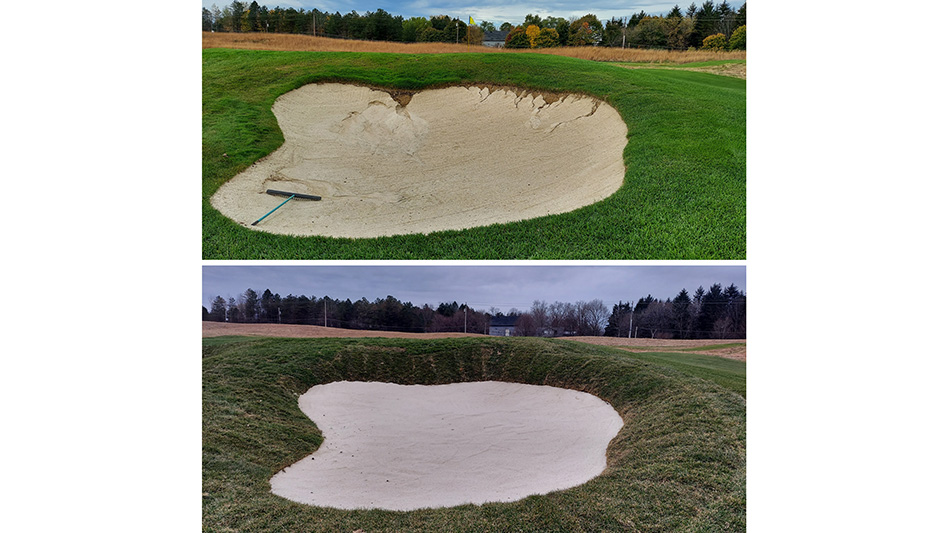
Ian Gallagher (3)
Installing bunker liners is a major operation for any club that does not have bottomless pockets. But Sand Ridge Golf Club in Chardon, Ohio, has found that installing the ZLine system can easily be handled in-house, reducing the job’s cost.
Sand Ridge was designed by Tom Fazio and opened in 1998. It merged in 2006 with the much older Mayfield club, creating a two-site, 36-hole facility for members. In 2018, the club was acquired by Cleveland-based businessman Monte Ahuja. Superintendent Ian Gallagher joined the club in May 2019 and was immediately faced with a problem.
“The bunkers were still in their original form at that time,” he said. “The club had been discussing doing an in-house bunker renovation for a while, but had not pushed the button, and it was becoming urgent. At some point, a fabric liner had been installed, though the bunkers were never properly renovated — they took the sand out, put the liner in, and put the sand back. They were well past due for being rebuilt — the liner had degraded badly, and they weren’t performing very well.”
The club was determined that any renovation should be done in-house, which limited its choices.
“Some of the liners around now are very impressive, but it is hard, sometimes impossible, to install them yourself,” Gallagher said. “Plus, I was pretty certain that I didn’t want a hard liner. With a hard liner, you are at the mercy of the plant that supplies the material — and also, even though we’re told they will last a long time, there isn’t any proof of exactly how long. I’m 39 now, and I don’t want to have to pull hard liner out of my bunkers. It would be very difficult to get it out.”
Shortly after Gallagher started at Sand Ridge, he received a sample from ZLine of enough material to line one bunker. “I tried it and really liked it, so I decided it was the right solution for us. We started rebuilding our bunkers in the fall of 2019, and we have been doing so since, at a rate of 10 to 15 yearly. We have perhaps 15 bunkers left to do, and we aim to be finished by the end of 2025. We had 100 bunkers and have eliminated 24 of them, and there are two that we need to move.

The project has stretched across years, Gallagher said, but “ZLine is really pretty easy to install, once you are used to it.
“The first year was a learning curve, but the company gave us training, and we now have a good system in place,” he said. “Because it is turf, it integrates with the ground really well, and getting material is easy: I call ZLine, tell them how many rolls we will need for a particular year, and it arrives. We have flexibility, which allows us to schedule the work better. The bunkers have mainly been done in the fall, because the weather cooperates better. Generally, we try to do perhaps six in the fall and three or four in the spring. This year has been different, the early spring weather was nice, so we got seven bunkers done.”
Gallagher is extremely happy with his new bunkers.
“Our soil is straight clay,” he said. “In the old bunkers, which have no functioning liner, after heavy rains — and all winter — the clay starts to wash in and really chokes the bunker. The new bunkers are a lot better. In renovating them, we’re returning them to their original size and edge. They get over-edged, and on a lot of them the sand was 18 inches higher than original. We don’t have very high flashed sand, but it’s high enough that if we get a two-inch thunderstorm, the bunkers are mostly washed out. Now, that doesn’t happen. We don’t get silt in the bunkers like we used to.”
Latest from Golf Course Industry
- SePRO to host webinar on plant growth regulators
- Turfco introduces riding applicator
- From the publisher’s pen: The golf guilt trip
- Bob Farren lands Carolinas GCSA highest honor
- Architect Brian Curley breaks ground on new First Tee venue
- Turfco unveils new fairway topdresser and material handler
- Ignite Attachments adds new box plane and grapple
- Mackenzie & Ebert working on new Caribbean course






